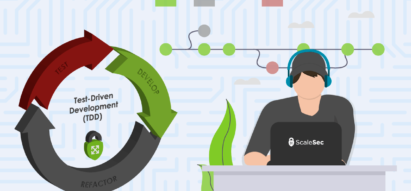In Domain-Driven Design (DDD), “knowledge crunching” refers to the process of distilling complex problem and concepts into more simplified and manageable forms. This can involve breaking down large amount of knowledge into smaller, more digestible pieces, as well as identifying and prioritizing the most important concepts and ideas.
In the context of DDD, knowledge crunching is often used to better understand all aspects of problem domain or system and to identify the key (lowest Level) abstractions and structures that can be used to model and design a solution. This process can involve working closely with domain experts and stakeholders to discover, detect, identify, gather and synthesize information, and can involve various techniques such as concept mapping, prototyping, and iterative design.
Overall, the goal of knowledge crunching in DDD is to help developers and designers create a shared understanding of the problem space, and to use that understanding to design effective and intuitive solutions that meet the needs of the users and stakeholders.
Some best practices for knowledge crunching in DDD include:
- Collaborate with domain experts: Involve domain experts and other stakeholders in the design process to ensure that you have a deep understanding of the domain and its requirements.
- Define the domain language: Establish a shared vocabulary and terminology for the domain that can be used consistently throughout the design process.
- Identify key concepts: Identify and model the key concepts and relationships within the domain using techniques such as entity-relationship diagrams and class diagrams.
- Create a domain model: Use the identified concepts and relationships to create a model of the domain that represents the real-world system and its behavior.
- Continuously refine the model: As you learn more about the domain and its requirements, continuously refine and update the domain model to ensure that it accurately reflects the current state of the domain.
- Use examples and scenarios: Use examples and scenarios to help clarify and validate the domain model and ensure that it accurately represents the real-world system.
- Seek feedback: value the feedback from domain experts and stakeholders in favor of accuracy of model and meets the needs of the domain in an iterative manner.
Also, these are some additional techniques, tools and structured ways that can be used for knowledge crunching specially to acquire the knowledge and distill it in domain-driven design:
- Event Storming: This is a collaborative workshop technique that helps teams understand and model the complex domain of a problem into events, commands, views, queries and etc. that can be handled in structured and decoupled way by identifying and organizing events and processes.
- Event modeling: this is a technique to understand and model the complex and dynamic behaviors within a domain. It involves identifying and organizing the events and processes that occur within a system, and using this information to create a model of the system’s behavior. In event modeling, events are represented as discrete occurrences that have a specific meaning and significance within the domain
- Interviews and focus groups: Conducting interviews or focus groups with domain experts and stakeholders can be a useful way to gather information about the domain and identify key concepts and relationships.
- Domain storytelling: Domain storytelling is a technique that uses narrative to explore and understand the complex relationships and behaviors within a domain. It can be used to help teams develop a shared understanding of the domain and identify key concepts and relationships.
- Research and analysis: Conducting research and analysis on the domain can help to deepen your understanding of the domain and identify patterns and trends that may be relevant to the design process. This can include reading industry reports, analyzing data, or conducting user research.
- Context maps: A context map is a visual representation of the relationships and dependencies between different bounded contexts within a domain. It helps teams understand how different parts of the domain fit together and how they interact with each other.
- Sketching and prototyping: Sketching and prototyping can be used to quickly test and validate ideas and concepts within the domain. These techniques can help teams get a better understanding of how the domain behaves and identify areas for further exploration and refinement.
- Reflection and iteration: It is important to take time to reflect on the knowledge that has been gathered and to iterate on the design as needed based on new insights and understanding. This can help to ensure that the domain model accurately reflects the real-world system and meets the needs of the domain.
- User stories: User stories are short, informal descriptions of a feature or functionality that describe the desired behavior from the perspective of the user. They can be used to capture and prioritize the requirements and functionalities of the domain.
Some additional tips for knowledge crunching in domain-driven design that is more high level and kind of cultural and strategic include:
- Encourage collaboration: Encourage team members to work together and share their knowledge and insights about the domain. This can help teams develop a deeper understanding of the domain and identify areas for improvement.
- Continuously learn: Keep learning about the domain by staying up-to-date on industry trends and best practices, and by seeking out new sources of knowledge and expertise.
- Be open to feedback: Be open to feedback and input from domain experts and other stakeholders. This can help you ensure that the model accurately reflects the needs and requirements of the domain.
- Keep it organized: Use tools such as knowledge management systems or documentation templates to help organize and manage the knowledge you have gathered about the domain. This will make it easier to refer back to this information as needed.
- Reflect on your process: Reflect on your knowledge crunching process regularly to identify areas for improvement and to ensure that you are using the most effective techniques and tools.
And here are a few considerations for knowledge crunching in domain-driven design on how to get started and do not get off the track:
- Start with the big picture: Begin by understanding the overall context and goals of the domain, and then work your way down to the details. This will help you identify the key concepts and relationships that are most important to the domain.
- Keep it simple: Don’t try to model every single detail or aspect of the domain. Instead, focus on the key concepts and relationships that are most important to the problem you are trying to solve.
- Be flexible: The domain model will evolve and change as you learn more about the domain. Be open to revising and updating the model as needed to reflect new insights and requirements.
- Avoid overgeneralization: Be careful not to oversimplify or overgeneralize the domain. Make sure that the model accurately reflects the complexity and specificities of the domain.
- Use visual aids: Visual aids such as diagrams, charts, and maps can be very helpful in understanding and representing the domain. They can make it easier to communicate and collaborate with others about the domain.
One more thing to consider when it comes to knowledge crunching in domain-driven design is the importance of maintaining the integrity and consistency of the domain model. It is important to ensure that the model accurately reflects the real-world system and its behavior, and that it is kept up-to-date as the domain evolves and changes. To do this, you may need to establish and follow a process for reviewing and updating the model on a regular basis.
Another thing to keep in mind is that knowledge crunching is an ongoing process. As you work with the domain, you will likely discover new insights and perspectives that can inform and improve your understanding of the domain. Therefore, it is important to be open to new ideas and approaches, and to be willing to revise and update your understanding of the domain as needed.
I Like to thanks Mr. Mehran Dalir for helping completing and proof reading of this post.


Leave your comment